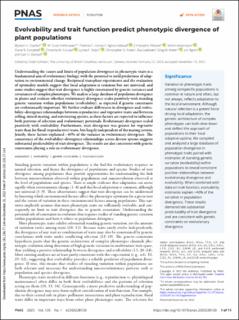| dc.contributor.author | Opedal, Øystein Hjorthol | |
| dc.contributor.author | Armbruster, Scott | |
| dc.contributor.author | Hansen, Thomas Fredrik | |
| dc.contributor.author | Holstad, Agnes | |
| dc.contributor.author | Pelabon, Christophe | |
| dc.contributor.author | Andersson, Stefan | |
| dc.contributor.author | Campbell, Diane R. | |
| dc.contributor.author | Caruso, Christina M. | |
| dc.contributor.author | Delph, Lynda F. | |
| dc.contributor.author | Eckert, Christopher G. | |
| dc.contributor.author | Lankinen, Åsa | |
| dc.contributor.author | Walter, Greg M. | |
| dc.contributor.author | Ågren, Jon | |
| dc.contributor.author | Bolstad, Geir Hysing | |
| dc.date.accessioned | 2023-01-03T13:03:40Z | |
| dc.date.available | 2023-01-03T13:03:40Z | |
| dc.date.created | 2023-01-02T12:20:23Z | |
| dc.date.issued | 2023 | |
| dc.identifier.issn | 0027-8424 | |
| dc.identifier.uri | https://hdl.handle.net/11250/3040666 | |
| dc.description.abstract | Understanding the causes and limits of population divergence in phenotypic traits is a fundamental aim of evolutionary biology, with the potential to yield predictions of adaptation to environmental change. Reciprocal transplant experiments and the evaluation of optimality models suggest that local adaptation is common but not universal, and some studies suggest that trait divergence is highly constrained by genetic variances and covariances of complex phenotypes. We analyze a large database of population divergence in plants and evaluate whether evolutionary divergence scales positively with standing genetic variation within populations (evolvability), as expected if genetic constraints are evolutionarily important. We further evaluate differences in divergence and evolvability– divergence relationships between reproductive and vegetative traits and between selfing, mixed-mating, and outcrossing species, as these factors are expected to influence both patterns of selection and evolutionary potentials. Evolutionary divergence scaled positively with evolvability. Furthermore, trait divergence was greater for vegetative traits than for floral (reproductive) traits, but largely independent of the mating system. Jointly, these factors explained ~40% of the variance in evolutionary divergence. The consistency of the evolvability–divergence relationships across diverse species suggests substantial predictability of trait divergence. The results are also consistent with genetic constraints playing a role in evolutionary divergence. adaptation | evolvability | genetic constraints | macroevolution | en_US |
| dc.language.iso | eng | en_US |
| dc.publisher | PNAS, | en_US |
| dc.rights | Navngivelse 4.0 Internasjonal | * |
| dc.rights.uri | http://creativecommons.org/licenses/by/4.0/deed.no | * |
| dc.title | Evolvability and trait function predict phenotypic divergence of plant populations | en_US |
| dc.title.alternative | Evolvability and trait function predict phenotypic divergence of plant populations | en_US |
| dc.type | Peer reviewed | en_US |
| dc.type | Journal article | en_US |
| dc.description.version | publishedVersion | en_US |
| dc.subject.nsi | VDP::Zoologiske og botaniske fag: 480 | en_US |
| dc.subject.nsi | VDP::Zoology and botany: 480 | en_US |
| dc.source.volume | 120 | en_US |
| dc.source.journal | Proceedings of the National Academy of Sciences of the United States of America | en_US |
| dc.source.issue | 1 | en_US |
| dc.identifier.doi | 10.1073/pnas.2203228120 | |
| dc.identifier.cristin | 2098747 | |
| dc.relation.project | Norges forskningsråd: 287214 | en_US |
| dc.relation.project | Andre: Crafoord Foundation (grant nr. 20210661) | en_US |
| dc.relation.project | Norges forskningsråd: 275862 | en_US |
| dc.relation.project | Andre: Swedish Research Council (grant nr. 2021-04777) | en_US |
| dc.relation.project | Andre: Norwegian Academy of Science and Letters | en_US |
| cristin.ispublished | true | |
| cristin.fulltext | original | |
| cristin.qualitycode | 2 | |

